St Anne’s Church Limehouse
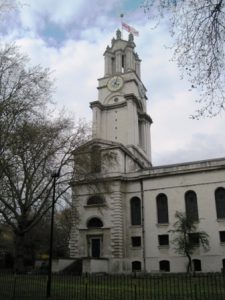
St Anne’s Church Limehouse – Description
St Anne’s Church Limehouse is a Baroque church designed by Nicholas Hawksmoor, consecrated in 1730 and Grade I listed in 1950. It has the second highest Gothic-style tower in Britain topped only by the Clock Tower of the Houses of Parliament. Until recently the golden ball on the flagpole above the tower was a Trinity House sea mark for navigating the Thames. The ball forms a part of a weather vane and is marked with the 4 cardinal points of the compass to indicate the direction of the wind. Below the ball the church flies the White Ensign, normally reserved exclusively for the Royal Navy. The church is shaped like a Greek cross, has Corinthian columns and an elongated nave, and the ceiling forms a great flat circle edged by Corinthian moulding.
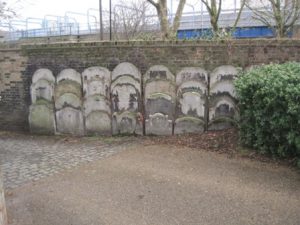
St Anne’s Church Limehouse – History
St Anne’s Limehouse is one of 12 churches known as the Queen Anne churches which were intended to cater for London’s rapidly expanding population (and possibly because all of the existing graveyards were full as a result of the plague of 1666). It was built as a result of a 1711 Act of Parliament. Queen Anne initiated the scheme and raised money for it by imposing a tax on coal coming up the River Thames. Other Queen Anne churches include St Mary le Strand and St Alfege Greenwich. The tower of St Anne’s Church was originally designed for St Alfege’s but was not erected there because of a lack of funds.
St Anne’s was gutted by fire in 1850 and was restored between 1851 and 1854 by Philip Hardwick. The roof and tower were restored further in 1983 and 1993, when tubular steel trusses were added to support the roof. The pipe organ won first prize in the Great Exhibition of 1851 and is much prized by musicians.
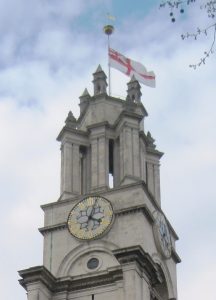
St Anne’s Church Limehouse – The Clock
Before the days of radio it was very important for a ship to keep an accurate record of the time as this allowed the navigator to determine the ship’s position when at sea. One of the jobs of the Royal Greenwich Observatory located to the south of St Anne’s (on the top of a hill in Greenwich Park) was to set and keep the standard of measurement of time. The exact time was transmitted by the observatory by dropping a large red ball on the top of the tower at exactly 1pm every day. This would have been visible from the top of the tower of St Anne’s and the tower clock would be set accordingly. The clock in the tower is still the highest church clock in London, had the first illuminated clock face in the country, and its elevation enabled it to be seen by the thousands of ships which moored every day in the surrounding docks. The clock used to chime four times every hour for the benefit of shipping and it is likely that the golden ball on the top of the flagpole was intended to be a facsimile of the Greenwich Time Ball and act as a kind of hallmark reassuring navigators that this was the St Anne’s clock and synchronised to Greenwich time.
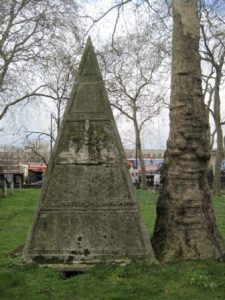
St Anne’s Church Limehouse – The Pyramid
The purpose of a large four sided pyramid in the graveyard of St Anne’s Church is a mystery. The four pinnacles on the main west tower are capped with pyramids with a similar shape but much smaller. The top of one of the faces of the grounded pyramid is inscribed with the words ‘The Wisdom of Solomon’ and under it is carved a raised coat of arms on which a unicorn is discernable to the left.
The pyramid is listed Grade II (List entry Number: 1031537) with the description “Churchyard monument in the form of a pyramid, c1730. Portland stone. Square pyramid, each face divided into five fielded panels. Worn armorial relief on the south side below the inscription “THE WISDOM OF SOLOMON”. An engraving of St Anne’s Church (qv) by Woods after Hablot Browne, c1850, shows the monument raised on a low square base and surrounded by railings”.
Some commentators state that beneath the English inscription are the same words in Hebrew but that is not visible now and is not mentioned in the English Heritage listing description above.
The English Heritage description is suggestive of the pyramid being a churchyard monument. A Hawksmoor church – St-George-In-The-East (started in 1714) – in Cannon Street Road has a square marble pyramid memorial on a two stage base with a coat of arms on the south face and dating from 1738.
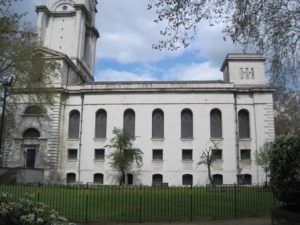
Many sources write that the pyramid was originally intended to be put atop one of the short eastern towers of the church and that an early drawing shows the towers capped with pyramidal or domed tops. From the vantage point of the Docklands Light Railway and on satellite photographs it can be seen that both towers are indeed already capped with shallow pyramids (probably to prevent pools of water forming) and there is no room for the one in the churchyard. In addition the towers are 19 metres high and their plinths some 6 metres in width and the pyramid in the graveyard, whose base is just over 2 metres across, would be lost on top of one of these.
Another possibility is the the pyramid was originally intended to be positioned between the two towers – an early design for St-George-In-The-East involved two stair turrets flanking a lower centrally positioned pyramid.
Perhaps the pyramid was intended to be on top of Hawksmoor’s original design for a tower at St Anne’s, and that design was superceded by the St Alfrege’s tower.
Or maybe the pyramid was intended for a completely different development, delivered to the church from the quarry in error and not returned. The postage would have been phenomenal.
Whatever the truth of the matter, something is living in that big hole burrowed under the south face of the pyramid!
St Anne’s Church Limehouse – Website
St Anne’s Church Limehouse – Getting There
Address: 5 Newell Street E14 7HP
Nearest Underground/DLR stations: Westferry DLR (9 minute walk)
(click on station to find other places to visit nearby)